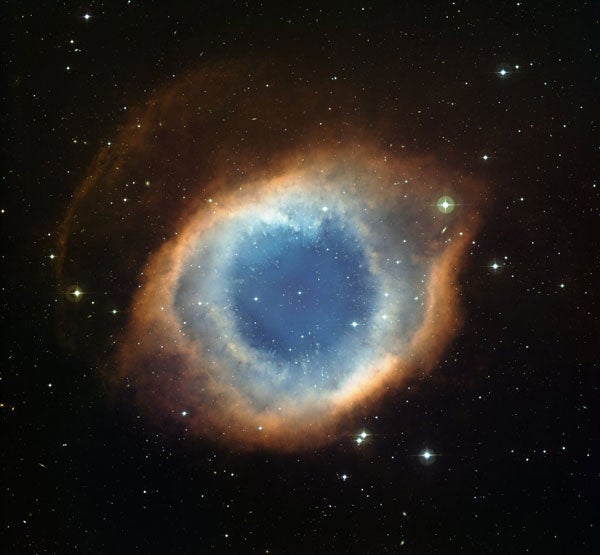This image was created from images through blue, green and red filters and the total exposure times were 12 minutes, 9 minutes, and 7 minutes, respectively.
Astronomers have obtained a deep new image of the magnificent Helix planetary nebula using the Wide Field Imager at the European Southern Observatory (ESO) in Chile. The image shows a rich background of distant galaxies, usually not seen in other images of this object.
The Helix Nebula (NGC 7293) lies about 700 light-years away in the constellation Aquarius the Water Bearer. It is one of the closest and most spectacular examples of a planetary nebula.
These exotic objects have nothing to do with planets, but are the final blooming of Sun-like stars before their retirement as white dwarfs. Shells of gas are blown off from a star’s surface, often in intricate and beautiful patterns, and shine under the harsh ultraviolet radiation from the faint, but very hot, central star. The main ring of the Helix Nebula is about 2 light-years across, or half the distance between the Sun and its closest stellar neighbor.
Despite being photographically very spectacular, the Helix is hard to see visually as its light is thinly spread over a large area of sky. It first appears in a list of new objects that German astronomer Karl Ludwig Harding compiled in 1824. The name Helix comes from the rough corkscrew shape seen in earlier photographs.
Although the Helix looks very much like a doughnut, studies have shown that it possibly consists of at least two separate disks with outer rings and filaments. The brighter inner disk seems to be expanding at about 62,000 mph (100,000 km/h) and to have taken about 12,000 years to form.
Because the Helix is relatively close — it covers an area of the sky equaling about a quarter of the Full Moon — scientists can study it in much greater detail than most other planetary nebulae. They have found it to have an unexpected and complex structure. All around the inside of the ring are small blobs, known as “cometary knots,” with faint tails extending away from the central star. They look remarkably like droplets of liquid running down a sheet of glass. Although they look tiny, each knot is about as large as our solar system. Astronomers have studied extensively these knots, both with the ESO Very Large Telescope and with the NASA/ESA Hubble Space Telescope, but still only partially understand them.
A careful look at the central part of this object reveals not only the knots, but also many remote galaxies seen right through the thinly spread glowing gas. Some of these seem to be gathered in separate galaxy groups scattered over various parts of the image.










